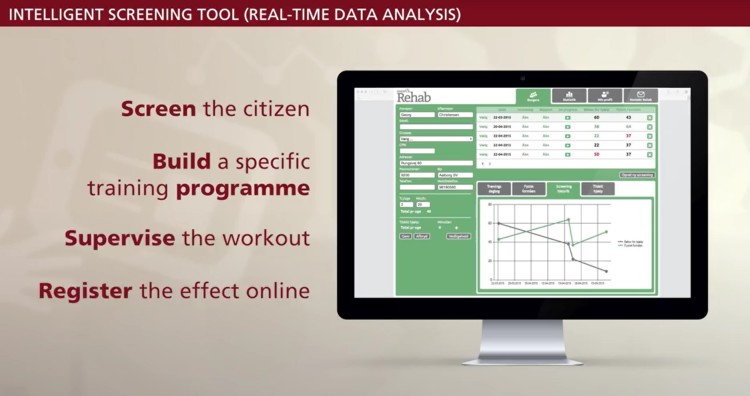I am participating in an massive online open course (MOOC) from the University of Copenhagen and Copenhagen Business School on the topic of Innovating Solutions for Aging Populations.
The free course is offered through Coursera; it started June 6th and runs until July 17th. You can read more about the course and sign up for future offerings at: https://www.coursera.org/learn/health-care-innovation
Week 3: Rehabilitation
In this module you will learn about the Danish healthcare system, how the financial resources are dispersed and how the public and private expenditures are organised – with a special focus on rehabilitation. Finally, you will be introduced to a rehabilitation tool developed by the Danish company, DigiRehab.
Lecture 1: Rehabilitation and the elderly
This week’s video lectures started by giving a brief, but comprehensive, overview of the Danish health and social care system, which is tax-funded, citizen-centred, and free for residents of Denmark to access. Currently, approximately 20% of the population is age 65 and older in Denmark (out of 5.5 million = approximately 1.1 million adults in this age category). Close to 10% of GDP in Denmark is spent on health care, similar to other European countries.
Then, the lectures segued into talking about rehabilitation and maintaining or increasing physical function could be a way to potentially reduce the cost of care for people with chronic conditions. One way to achieve this, which is being researched and integrated into Denmark, is through investing in technologies to support rehabilitation and specifically to reduce the costs of primary care.
What do they mean by rehabilitation? One of the earliest definitions of rehabilitation is from 1941 and defines it as planned attempts under skilled direction to restore or improve health, usefulness, and happiness of those who have had an injury or illness. This can be interpreted as actively helping them return to the community. Most current concepts of rehabilitation are shaped by the WHO International Classification of Functioning, Disability and Health (ICF) model, indicating a goal-oriented and collaborative process for rehabilitation.
It is also important to take a person-centred approach, which looks at the goals, situation, needs, and desires of the individual for their rehabilitation and tailors the process towards that. Together, the person-centred approach and ICF model acknowledge that rehabilitation is not just for health and functional abilities, but also about the activities and desires of the individual going through the rehabilitation process and the everyday life of the person as a whole.
Particularly relevant for aging and older adults, Denmark has initiated a system for “everyday rehabilitation,” which focuses on increasing activity and competence levels so that people can function as highly as possible in their daily routines with as much personal independence as possible. These would include using rehabilitation for activities such as housekeeping, food shopping and meal preparations, hygiene and self-care, in order to maintain independence before offering passive services through the health and social care system.
Digirehab and Steno Diabetes Center in Denmark working on innovative ways to redefine rehabilitation.
Digirehab offers intelligent welfare technological approach to rehabilitation in the municipalities. The core of rehab is an objective screening of the citizen’s need for assistance and the physical abilities and together they form an extremely accurate picture of people’s rehabilitation potential. With Digirehab you get an overview of who can benefit from training, help implement it and get the full and well-documented overview of the impact of action – in real time!
Steno Diabetes Center is specialised in patient care, research, and prevention of diabetes, and in education of health care professionals within diabetes. Steno is the biggest diabetes clinic in Scandinavia and treats annually more than 5.700 people with diabetes from the Capital Region of Denmark.
Quiz
Q1. How is Danish healthcare financed?
A1. Mainly tax financed but specific areas requires healthcare insurances
Q2. Everyday rehabilitation is defined by:
A2. Rehabilitation with specific focus on everyday tasks
Q3. ICF is the short form for:
A3. International Classification of Functioning, Disability and Health
Lecture 2: Digirehab Case
Getting a bit more into aging aspects, a physical therapist from Digirehab talked about how it is inactivity that causes physical weakness, not age itself, and that rehabilitation for older people has been successful at supporting them to be more physically active and independent. Digirehab uses the 5-step IDEAL problem-solving cycle for their solution:

Digirehab is an electronic-based screening tool to help professionals (and, ultimately, individuals) in rehabilitation to make as many citizens as possible as self-reliant as possible.

While the tool definitely has some merit, and is a relatively good example of eHealth from what I can tell, it also seems to be heavily focused on the admin side and not as much about patient support and empowerment.
Quiz
Q1. Which of the following sentences is correct?
A1. It is never too late to improve your physical performance
Q2. What is the thought behind DigiRehab’s tool?
A2. Physical and functional capacity is correlated
Q3. What does DigiRehab’s tool do?
A3. It enables healthcare personnel to build specific training programmes, supervise the workout and register the effect online